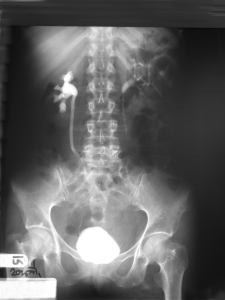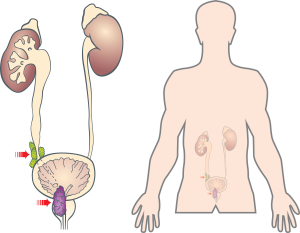Prostate cancer symptoms are absent in the beginning of prostate cancer. Prostate cancer and breast cancer are similar not only histologically, but also by the fact that both have no symptoms in the early stages.
If we wait therefore for symptoms to occur, then we wait until the cancer is incurable. However, since the 1980’s all of that changed rapidly with the screening test “prostate specific antigen”(=PSA for short). With this simple blood test anything higher than a value of 5 is suspicious and should be examined and further investigated with a prostate biopsy by a urologist (Ref. 1 and 3). However, Dr. Lee (Ref. 10) pointed out that not only prostate cells produce PSA, but also normal breast tissue, so that one has to be careful when interpreting PSA levels. As an older man has less testosterone and progesterone production, there is a selective process that occurs within the prostate gland allowing abnormal and cancer cells to be more prominent that tend to produce more PSA. PSA has a function of inhibiting angiogenesis, where tumor cells secrete angiogenic factors to create new blood vessels that feed the prostate cancer cells. In overcrowded conditions in the prostate gland such as in benign prostate hypertrophy, but also with prostate cancer, the normal prostate gland cells produce PSA as a defense against the cancer cells that are prolific. These details have to be kept in mind when interpreting PSA results (Ref.10).
The problem is that benign prostatic hyperplasia will also increase the PSA level. Also, occasionally there is a case of a prostate cancer where the cells are so immature histologically that they do not lead to an increase in prostate specific antigen. The PSA test will be normal, but the rectal examination will be abnormal (a hard lump will be palpable to the doctor’s examining finger). All of these cases need to be referred to a urologist as a needle biopsy (approach through the rectum) will have to reveal what the underlying diagnosis is. Otherwise, if the patient did not go for his yearly check-up test (rectal exam and PSA test), the cancer will be undetected and exert more and more pressure onto the upper urethra until there is a change in the urinary stream or it comes to an abrupt halt with an acute urinary retention. This is an emergency and requires a suprapubic catheter to drain the urine and an emergency referral to a urologist. Another symptom may be blood in the urine, well before the bladder obstruction occurs. In this case the upper urethra likely has been invaded by the cancer leading to blood in the urine. There may be a sudden inability to pass urine (urinary obstruction when the prostate cancer obstructs the upper urethra or the lower ureter). When the ureter gets obstructed, hydronephrosis (a ballooning of the kidney) can develop on the affected side, which can be seen on X-rays (see image here).
The underlying mechanism for this is that some cancer cells have broken loose from the original prostate tumor and formed metastases in the lymph glands around the lower right ureter as depicted in the other image. The metastases can encase the ureter, obstruct it and lead to a back-up of urine in the affected kidney causing the hydronephrosis. This is an emergency that has to be seen right away by a urologist.
Even later symptoms are pelvic pain (due to lymph gland metastases), back pains, bone pain (all due to bone metastases), and metastases in other organs such as the lung, the brain, liver or kidneys. Other late symptoms are rapid weight loss, decreased appetite and loss of energy.
___________________________________________________
Women: tell your man to see his physician once per year for a rectal exam and a blood test to check the PSA level (prostate screening)!
___________________________________________________
If the PSA level is measured once per year from the 50th birthday onwards, any change to a higher value would become very obvious. See table below:
Rate of Prostate cancer reflected by PSA level
| PSA value: | Rate of biopsy proven prostate cancer: |
| less than 5 | 4% |
| between 5 and 10 | 33% |
| more than 10 | 55% |
This table makes it obvious why it is important to track the PSA level over the years. In addition to the PSA screening a rectal exam needs to be done and in suspicious cases a needle biopsy may be required. This can now be done by the urologist on a daycare basis or in the office setting.
References:
The following references were used apart from my own clinical experience:
1. Cancer: Principles &Practice of Oncology, 4th edition, by V.T. De Vita,Jr.,et. al J.B. LippincottCo.,Philadelphia, 1993.Vol.1: Chapter on Prostate cancer.
2. The Merck Manual, 7th edition, by M. H. Beers et al., Whitehouse Station, N.J., 1999.Chapter 233, p.1918-1919.
3. Cancer: Principles&Practice of Oncology. 5th edition, volume 1. Edited by Vincent T.DeVita, Jr. et al. Lippincott-Raven Publ., Philadelphia,PA, 1997. Chapter on prostate cancer.
4. A Waghray et al. Cancer Res 2001 May 15;61(10):4283-4286.
5. BM Fisch et al. Urology 2001 May;57(5):955-959.
6. CC Parker et al. BJU Int 2001 May;87(7):629-637.
7. B Aschhoff Drugs Exp Clin Res 2000;26(5-6):249-252.
8. Conn’s Current Therapy 2004, 56th ed., Copyright © 2004 Elsevier
9. Ferri: Ferri’s Clinical Advisor: Instant Diagnosis and Treatment, 2004 ed., Copyright © 2004 Mosby, Inc
10. John R. Lee: “Hormone Balance for Men – What your Doctor May Not Tell You About Prostate Health and Natural Hormone Supplementation”, © 2003 by Hormones Etc.








